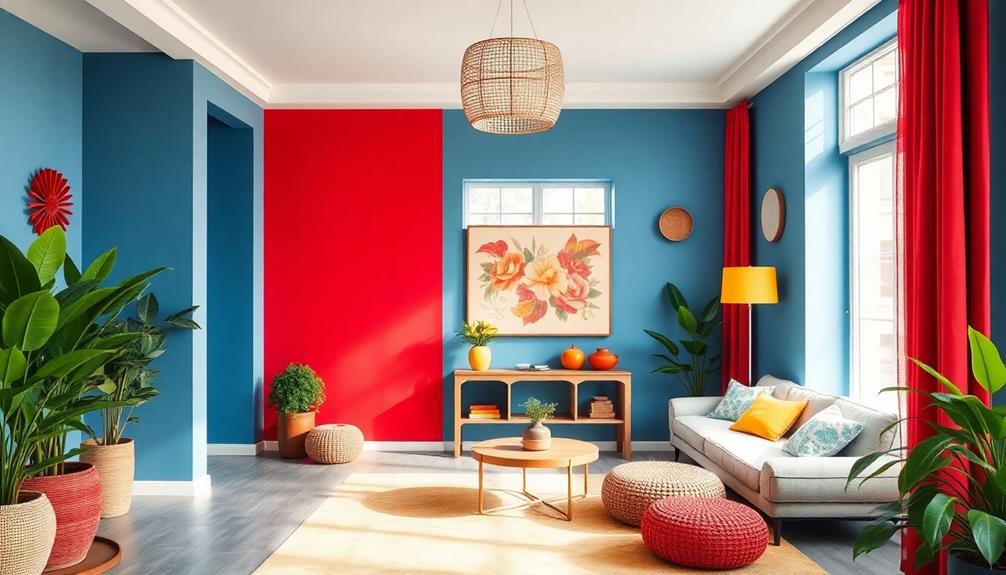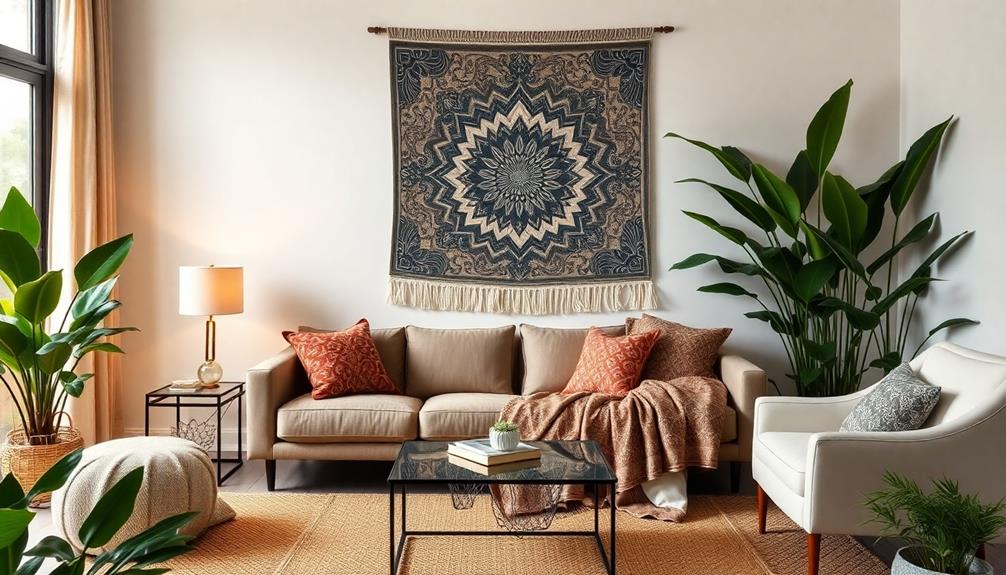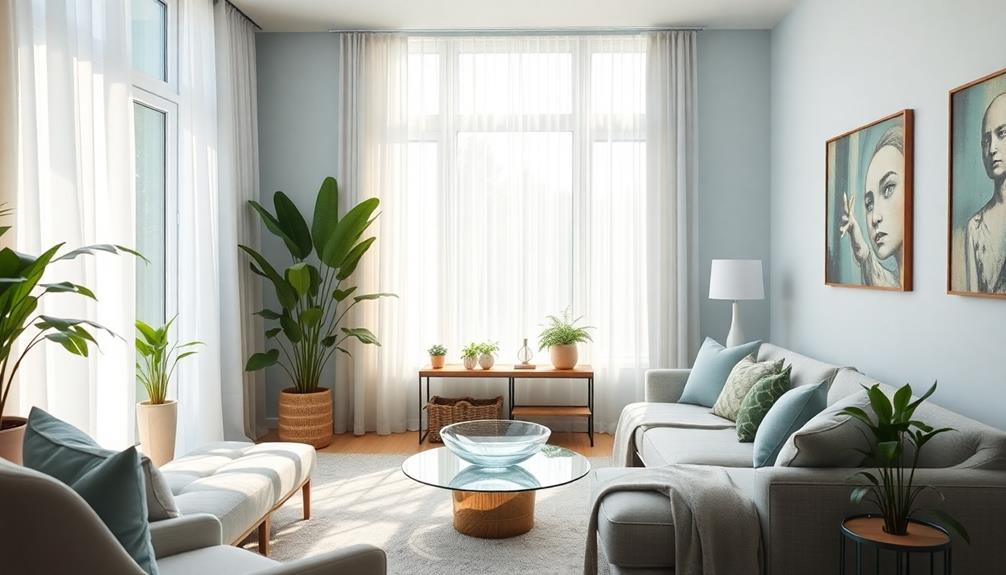Feng Shui colors can drastically change the energy in your space, affecting your mood and well-being. Active colors like red and orange ignite passion, while blues and greens promote calmness and growth. Balancing these colors according to their elemental associations helps create harmony in your home. For example, using earthy tones in living areas fosters stability, while brighter shades can energize kitchens. It's essential to assess your color choices regularly to avoid negative energy build-up. When you start incorporating these principles, you'll notice a shift in your space's vibe, and there's more to explore on this topic!
Key Takeaways
- Colors influence emotions and perceptions, significantly affecting how spaces are experienced and interacted with.
- Each color corresponds to specific feng shui elements, impacting the energy dynamics within a space.
- Balancing colors is crucial; overusing a single color can create tension and disrupt positive energy flow.
- Strategic placement of colors based on direction enhances specific life aspects, like career luck and family harmony.
- Regular assessment and adjustment of color schemes maintain a harmonious and energetically balanced living environment.
The Psychology of Color
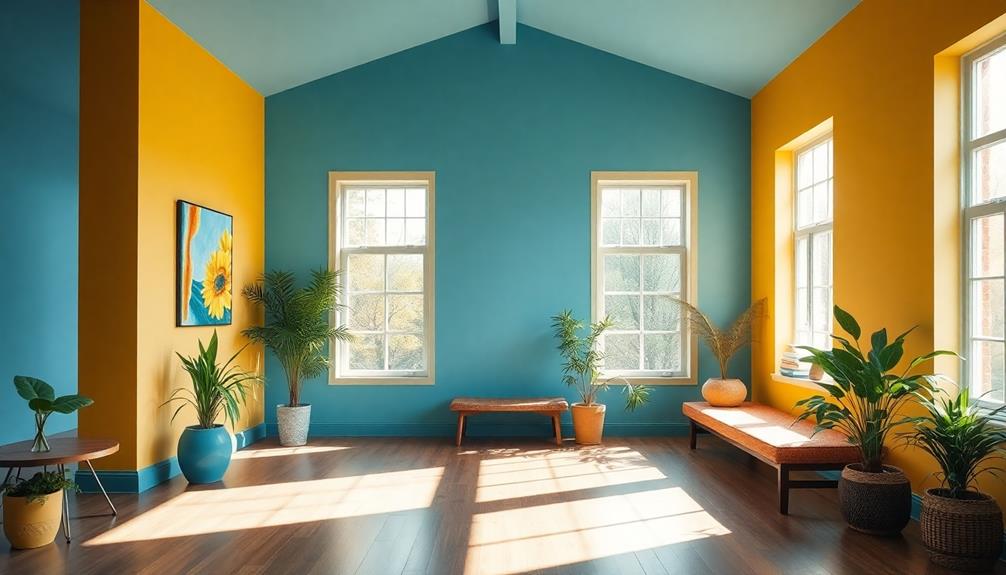
Color plays a crucial role in shaping our perceptions and decisions, often without us even realizing it. You mightn't be aware, but 85% of shoppers cite color as a primary reason for their purchasing decisions. This influence extends beyond shopping; color psychology impacts how you engage with brands and products.
For instance, when you see a red button instead of a green one, your likelihood of clicking on it can change considerably. Incorporating vibrant colors, such as those found in Indonesian decorative pillows, can enhance the emotional ambiance of your living space, reflecting cultural heritage.
Emotional connections to specific colors can also foster brand loyalty. You might gravitate towards blue because it evokes feelings of trust and reliability. Marketers understand this, leveraging color psychology in their strategies to enhance sales. The right colors can stir your emotions and drive you to take action.
However, it's important to recognize that colors don't have universal meanings. Cultural and contextual variations can lead to different reactions. What energizes one person might calm another.
Color Principles in Feng Shui
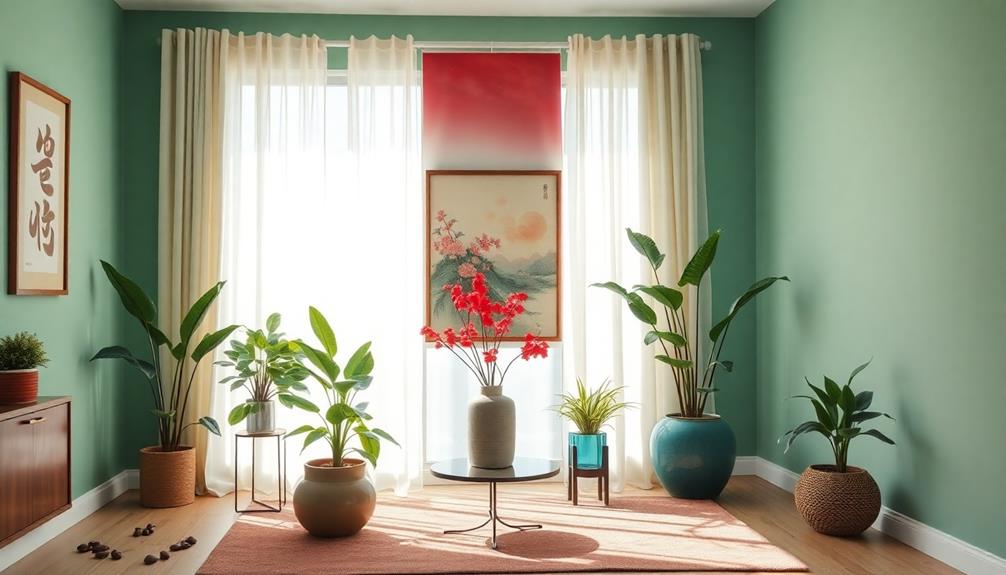
When it comes to color principles in feng shui, you'll notice how color energy can markedly influence your environment.
Each color is tied to specific elements, and understanding these associations helps you make informed choices for your space.
For instance, incorporating traditional Indonesian style home decor can enhance the natural energy flow in your rooms.
Balancing these colors is essential, as overusing one can disrupt harmony and create unwanted tension.
Color Energy Influence
Often, the energy of a space can be dramatically influenced by the colors you choose. Understanding how colors can be used in feng shui can enhance the atmosphere and energy into your home. By selecting the right feng shui colors, you can evoke emotional responses to colors that align with your intentions.
Here's a quick reference table to help you choose:
| Color | Element | Energy Influence |
|---|---|---|
| Red | Fire | Passion and energy |
| Blue | Water | Calmness and tranquility |
| Green | Wood | Growth and renewal |
| Earthy Tones | Earth | Stability and nurturing |
For example, using blue and black in the North can promote career luck, while earthen tones in the South balance excessive fire energy. You'll find that softer hues in bedrooms improve sleep quality, whereas vibrant colors in living rooms can energize social interactions. Regularly evaluating your color scheme is essential, as imbalanced colors can lead to negative energy and hinder your well-being. Choose wisely, and let the right colors transform your space!
Elemental Color Associations
Elemental color associations play an essential role in feng shui, influencing the energy flow within your home. Each of the five elements—wood, fire, earth, metal, and water—corresponds to specific colors that can enhance or hinder the energy in different areas.
For example, the wood element is represented by green, promoting growth and liveliness, while the fire element is associated with colors like red and orange, energizing spaces but needing to be balanced to avoid overheating. In Balinese interior design, natural materials are often complemented by these elemental colors to create a harmonious environment.
The water element, linked to the north, is represented by blue and black, important for career luck and tranquility. You should use these colors strategically to enhance specific qualities in your home.
In contrast, earthy tones represent the earth element, providing stability, while metallics reflect the metal element, adding clarity.
Understanding these elemental color associations helps you create a harmonious environment. For instance, incorporating color red can invigorate a space but may lead to disputes if overused.
Balancing Color Dynamics
Understanding how to balance color dynamics in your space enhances the principles of feng shui you've explored with elemental color associations. Feng shui uses the five elements—fire, water, metal, earth, and wood—each represented by specific colors that influence energy dynamics and emotional responses.
Incorporating decorative pieces like traditional artistry can further enhance the aesthetic appeal of your space. When balancing colors, be mindful of how their interactions can impact harmony; for example, excessive blue can drain energy, affecting finances and emotional stability.
To create a positive flow, embrace the creative, destructive, and productive cycles of these elements. Incorporating earth tones can counterbalance an overabundance of water elements, fostering stability.
Each area of your home corresponds to different life aspects, so strategic color placement is essential. Use green in the East for family health or earthy tones in the Southwest to enhance romance.
Regularly assess your color schemes and their effects on energy dynamics. By adjusting colors, you can cultivate a harmonious living environment that supports your well-being and personal growth.
Colors and Their Energies
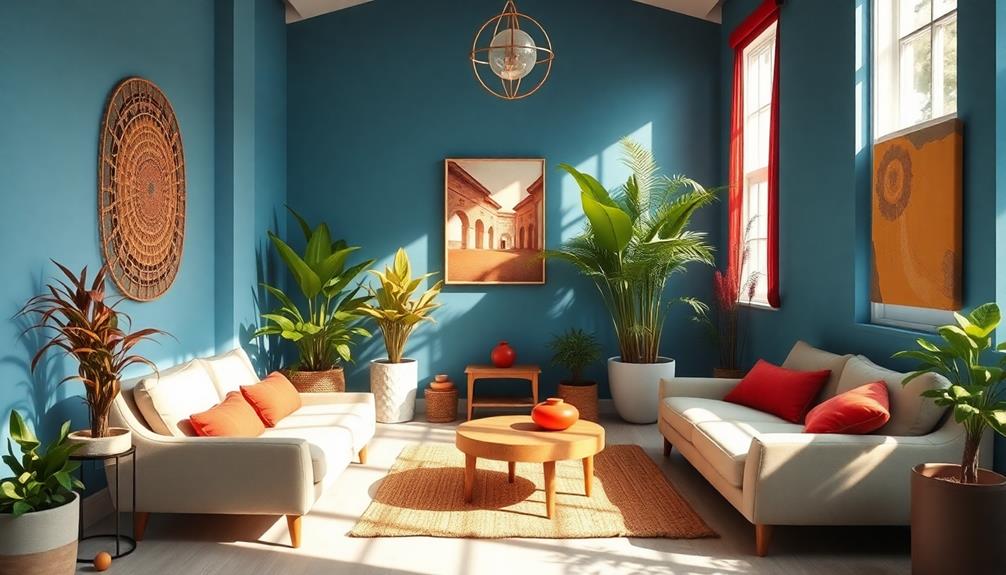
Colors have a powerful emotional impact that can shape the atmosphere of your space. By understanding the associations and meanings behind each color, you can harmonize your surroundings to support your well-being.
For instance, incorporating vibrant colors in your decor, like those found in Indonesian wedding decor ideas, can enhance the energy and mood of a space.
Let's explore how these color energies can enhance your life and create balance in your home.
Emotional Impact of Colors
Every color you encounter carries a unique energy that can notably impact your emotions and overall well-being. By understanding the emotional connections tied to different colors, you can consciously make color choices that enhance your living space.
For instance, active colors like red and orange can ignite passion and energy, while passive colors such as blue and gray foster calmness and tranquility. Incorporating elements like a Face Indonesian Decor Mask can also introduce vibrant colors and cultural significance, enriching the emotional atmosphere of your home.
The psychological impact of these colors can influence not only your mood but also your behavior. Bright colors like yellow stimulate happiness and are ideal for kitchens, promoting an inviting atmosphere. In contrast, softer colors in bedrooms encourage relaxation, paving the way for restful sleep.
Moreover, the right color choices can notably improve the energy flow in your environment, aligning your space with your desired emotional outcomes. Whether you're looking to boost creativity or create a sanctuary for relaxation, recognizing how colors affect your emotions empowers you to transform your surroundings.
Color Associations and Meanings
In feng shui, color associations play a crucial role in shaping the energy of your space. Each color corresponds to a specific feng shui element, influencing the atmosphere and your well-being. Understanding these associations can help you create a harmonious environment and enhance the aesthetic appeal of your home decor, much like how Indonesian decor masks bring cultural richness and uniqueness to a space.
- Red color: Linked to passion and vitality, it can energize a room but be cautious—too much can lead to conflict.
- Green: Symbolizing growth and renewal, it enhances health and family dynamics, especially in the East. Avoid using it excessively in bathrooms, as it can drain energy.
- Black color: Representing the water element, it promotes calmness and can enhance career opportunities when placed in the North.
- Earth tones: Cream and light brown foster stability and nurturing energies, perfect for bedrooms and living areas to support well-being.
- Blue: Also a water element, it brings tranquility and is ideal for creating serene spaces.
Harmonizing Colors in Spaces
Harmonizing your space through color involves understanding how different shades influence the energy around you. In feng shui, colors correspond to the five elements: fire, water, metal, earth, and wood. Each element plays an essential role in shaping the energy of specific areas in your home.
For instance, if you want to enhance your career luck, use blue or black in the North, where water resides. In the South, earthen colors can balance excessive fire energy. To create a serene atmosphere, consider integrating natural materials and open spaces for tranquility that complement your chosen color palette.
To promote health and family harmony, focus on green shades in the East, linked to wood. Conversely, if your kitchen or toilet emits negative wood energy, consider incorporating red or orange accents.
In the West, where metal thrives, blue or black tones can counteract bad metal energy, while earthen hues enhance positive vibes in living spaces.
Selecting Colors for Your Space
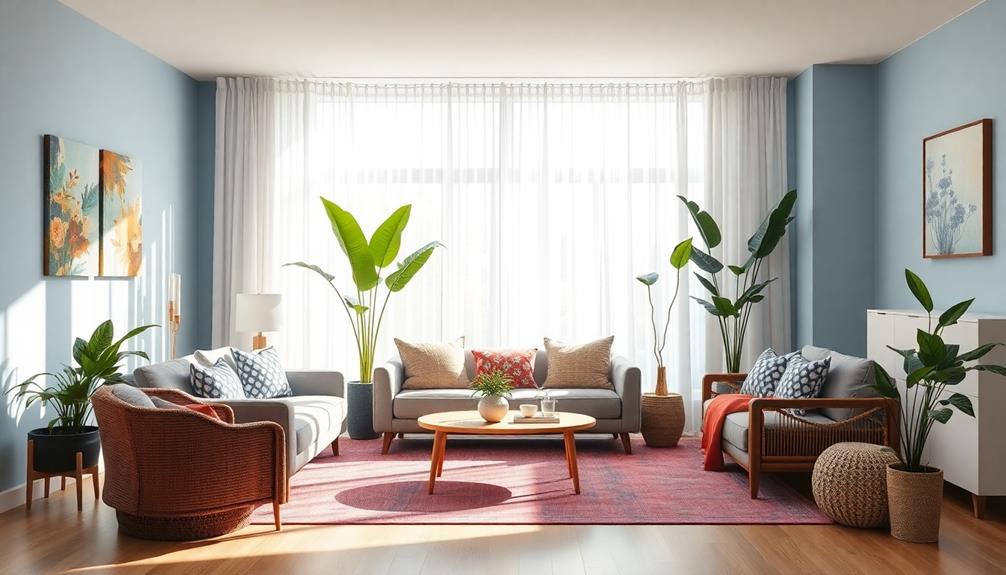
Choosing the right colors for your space can greatly impact its energy and ambiance. When selecting colors, consider the associated Feng Shui elements and how they influence your home.
For instance, incorporating natural elements and materials can enhance the overall vibe of your space, much like the designs from Mahallati Interiors which focus on luxury tropical aesthetics.
Here are some key points to keep in mind:
- Identify Elements: Red (fire) boosts passion, while blue (water) promotes calmness.
- Room-Specific Choices: Earthy tones in the South-West enhance romance, and greens in the East support family health.
- Balance is Key: Avoid excessive use of one color; limit vibrant colors like red to 1/9 of your total space to maintain harmony.
- Restful Hues: For bedrooms, opt for dimmer colors like soft greens or pastels to encourage relaxation and better sleep.
- Energy Mitigation: Use earth tones to balance excessive fire energy, especially in kitchens.
Color Applications by Direction
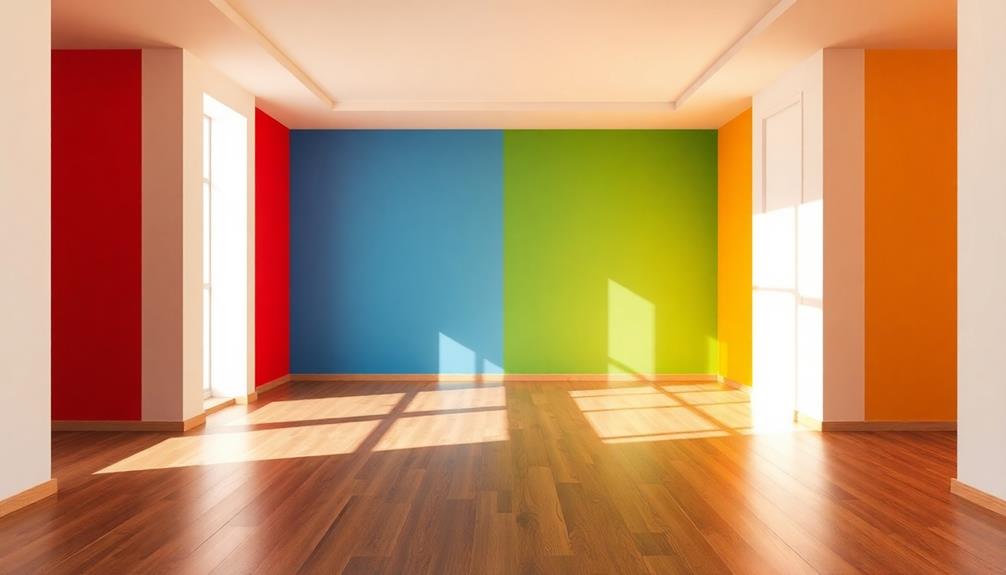
Understanding how colors interact with different directions is essential for enhancing the energy in your home.
In the North Direction, associated with the water element, you should use blue or black to boost your career luck. However, try to limit green shades, as too much can weaken the water energy. Traditional Indonesian housing often incorporates cultural symbolism that can be reflected in your color choices, enhancing the overall energy of your space.
For the South Direction, which represents the fire element, incorporating mild red tones in your living areas can promote name and fame, but be careful not to overdo it, as excessive red can create an imbalance.
In the East Direction, linked to wood, green is a calming choice for living rooms, while red and orange can help mitigate negative wood energy in kitchens or bathrooms.
For the West Direction, governed by the metal element, blue or black can counteract bad metal energy, while earthen colors like brown and yellow enhance positive vibes in your space.
Lastly, in the North-East Direction, ruled by the earth element, metallic colors like white and gold can combat negative energy, while bright yellow fosters optimism and concentration in study areas.
Balancing Yin and Yang
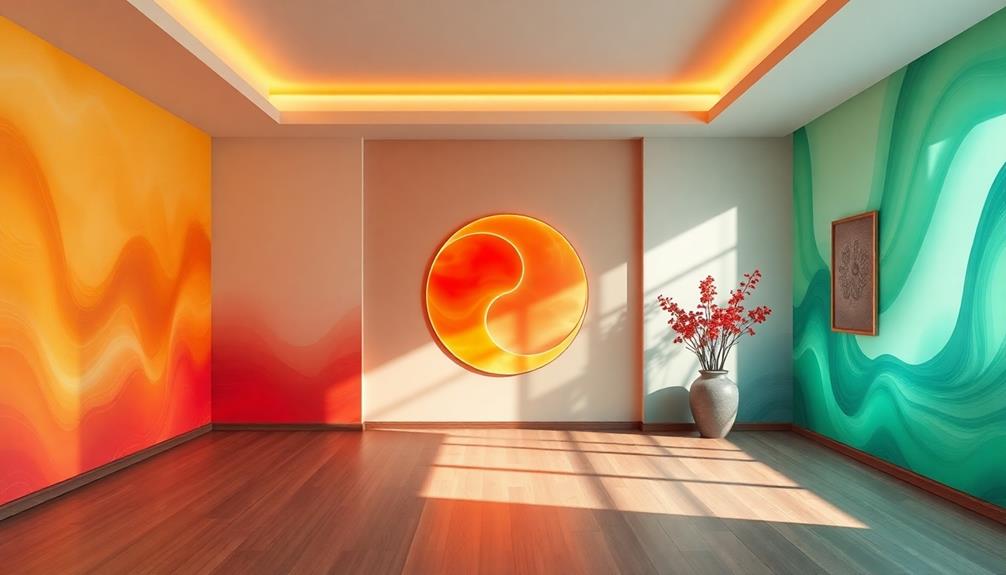
Achieving balance between Yin and Yang in your space is essential for fostering a harmonious environment.
Balancing these two elements through color selection can greatly impact the energy of your surroundings. You'll want to harmonize active (Yang) colors, such as vibrant reds and oranges, with passive (Yin) colors like blues and grays.
To create that balance, consider the following:
- Use Yang colors for energizing spaces like kitchens and home offices.
- Incorporate Yin colors in relaxation areas like bedrooms and lounges.
- Assess your color schemes regularly to maintain balance.
- Mix colors thoughtfully to avoid overwhelming or dulling the atmosphere.
- Aim for emotional stability by considering how colors influence mood.
Practical Tips for Color Use
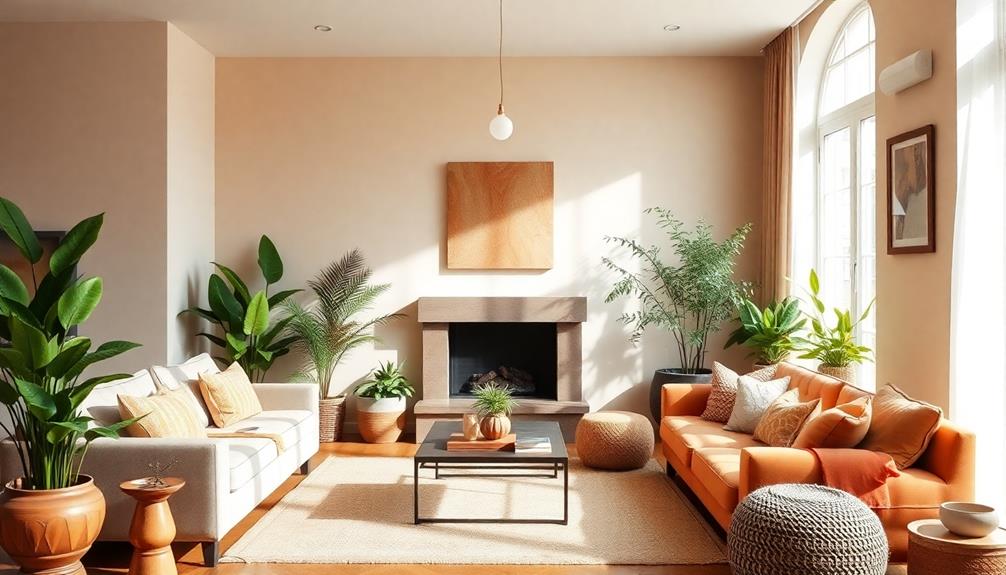
When it comes to using color in Feng Shui, it's all about creating an environment that fosters positive energy and well-being. To effectively enhance the energy of your spaces, consider the following practical tips for color use:
| Color | Element | Best Use |
|---|---|---|
| Red | Fire | Limit in kitchens; use sparingly |
| Green | Wood | Great for living areas; promotes growth |
| Blue | Water | Ideal for calming bedrooms; enhances tranquility |
| Earthy tones | Earth | Use in dining areas; fosters stability |
In Feng Shui Living, you want to harmonize exterior colors with your surroundings. For instance, if you're in a lush area, green tones can resonate well. Avoid overly vibrant colors like red in bedrooms to guarantee restful sleep; opt for soft hues like pink or peach instead. Regularly assess the colors for your home to guarantee they promote positive energy. Adjusting color schemes can meaningfully impact your overall well-being, so don't hesitate to use color thoughtfully!
Frequently Asked Questions
What Colors Should Be Avoided in Feng Shui?
In Feng Shui, avoid excessive black for draining energy, overpowering red to prevent chaos, green in kitchens or bathrooms for harmony, gray that feels cold, and harsh whites in bedrooms which hinder intimacy and warmth.
What Color Should I Paint My Room for Positive Energy?
You should paint your room in soft colors like light pink or muted green to promote relaxation and enhance positive energy. This will create a serene atmosphere that supports better sleep and overall well-being.
Can the Color of Your House Reduce Your Energy Footprint?
Yes, the color of your house can reduce your energy footprint. Lighter colors reflect sunlight, while earth tones create harmony, inspiring eco-friendly habits. Choosing the right colors promotes mindful living and efficient energy consumption.
What Is the Color Theory of Feng Shui?
The color theory of Feng Shui connects colors to the five elements, influencing energy and mood. By selecting colors mindfully, you can enhance specific life areas, fostering harmony and positive experiences in your living space.
Conclusion
By understanding the impact of colors in feng shui, you can transform your space into a harmonious haven. For instance, imagine repainting your living room in calming blues and greens. This simple change can promote relaxation and enhance communication among family members. You'll not only feel the difference but also notice how your home's energy shifts, creating a more inviting atmosphere. Embrace the power of color to cultivate the energy you desire in your space!
